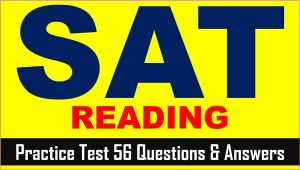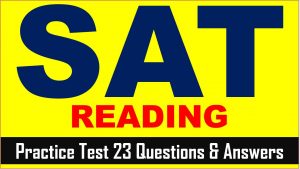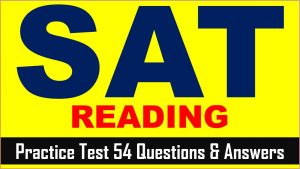SAT (Scholastic Assessment Test) is a standard test, used for taking admission to undergraduate programs of universities or colleges of the United States. SAT is developed and published by the College Board, an organization in the United States, administered by the Educational Testing Service. In this article of AKVTutorials, you will get SAT Reading and Writing Prep Test 38 | SAT 2024 Online Tutor AMBiPi.
SAT Reading Practice Passage
This passage is adapted from Rachel Ehrenberg, “Salt Stretches in Nanoworld.” ©2009 by Society for Science & the Public. The “nanoworld” is the world observed on a scale one billionth that of ordinary human experience.
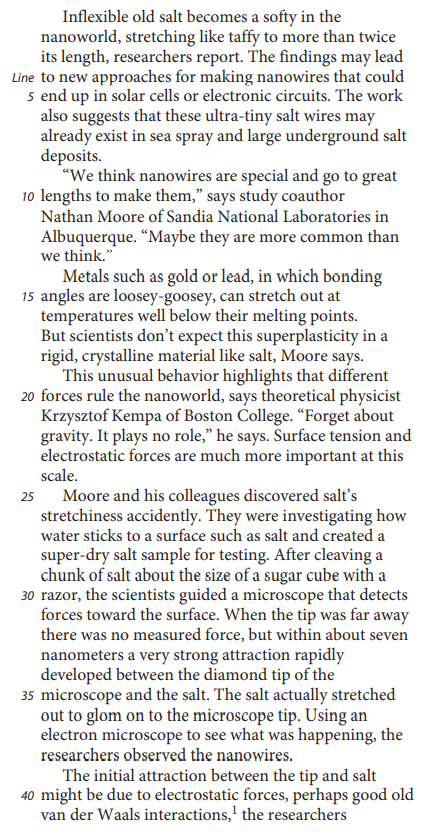
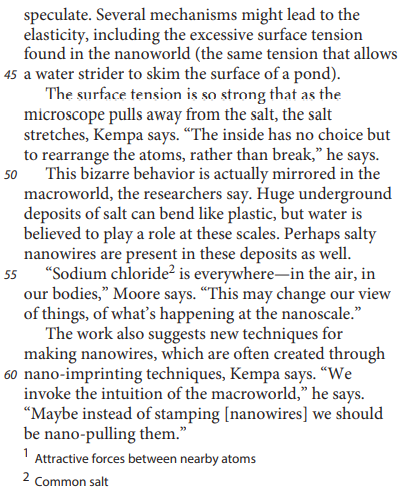
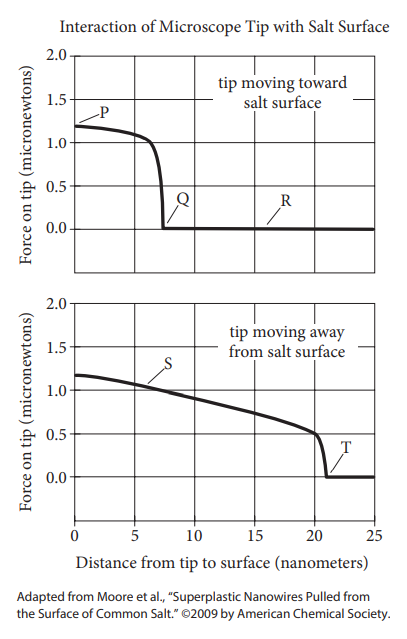
SAT Reading Comprehension Practice Test Questions
SAT Practice Test 38 Question No 1
One central idea of the passage is that
Option A: sometimes materials behave contrary to expectations.
Option B: systems can be described in terms of inputs and outputs.
Option C: models of materials have both strengths and weaknesses.
Option D: properties of systems differ from the properties of their parts.
SAT Practice Test 38 Answer No 1
Show/Hide Answer
Option A :
The first paragraph explains that in the nanoworld, salt can be seen “stretching like taffy.” The third paragraph notes that while this elasticity was expected in metals, it wasn’t imagined for salt: “But scientists don’t expect this superplasticity in a rigid, crystalline material like salt.” The rest of the passage explores this unexpected behavior of salt. Therefore it can be said that one of the central ideas of the passage is that materials don’t always behave as scientists might expect them to.
Choices B, C, and D are incorrect because the passage focuses on the unexpected way that salt reacts in the nanoworld, not on the role of inputs and outputs in systems (choice B), the relative strengths and weaknesses of models (choice C), or how the properties of systems differ from the properties of their parts (choice D).
SAT Practice Test 38 Question No 2
Which choice best describes the overall structure of the passage?
Option A: A list of several ways in which salt’s properties differ from researchers’ expectations
Option B: A presentation of a hypothesis regarding salt behavior, description of an associated experiment, and explanation of why the results weaken the hypothesis
Option C: A description of two salt crystal experiments, the apparent disagreement in their results, and the resolution by more sensitive equipment
Option D: An introduction to an interesting salt property, description of its discovery, and speculation regarding its application
SAT Practice Test 38 Answer No 2
Show/Hide Answer
Option D :
The first five paragraphs introduce salt’s ability to stretch “like taffy to more than twice its length.” In the fifth paragraph, the passage shifts into an explanation of how “Moore and his colleagues discovered salt’s stretchiness.” The last paragraph speculates about the possible application of this discovery: “The work also suggests new techniques for making nanowires, which are often created through nano-imprinting techniques.” The passage’s overall structure can therefore be seen as consisting of an introduction to an interesting salt property, followed by a description of how the property was discovered, followed by speculation regarding applications of this property.
Choice A is incorrect because the passage discusses only one way in which salt differed from researchers’ expectations. Choice B is incorrect because the passage begins not with a hypothesis about salt’s behavior but with an explanation of its behaviors. Choice C is incorrect because the passage discusses complementary observations of salt crystals rather than two experiments involving salt that yield seemingly conflicting results.
SAT Practice Test 38 Question No 3
Which choice provides the best evidence for the claim that Moore’s group was surprised to observe salt stretching?
Option A: Lines 17-18 (“But… says”)
Option B: Lines 26-28 (“They were… testing”)
Option C: Lines 36-38 (“Using… nanowires”)
Option D: Lines 55-56 (“Sodium… says”)
SAT Practice Test 38 Answer No 3
Show/Hide Answer
Option A :
That Moore’s group was surprised to observe salt stretching is most directly suggested by the last sentence of the third paragraph: “But scientists don’t expect this superplasticity in a rigid, crystalline material like salt, Moore says.”
Choices B, C, and D are incorrect because the cited lines don’t support the idea that Moore’s group was surprised to observe salt stretching. Instead, they explain how the group happened upon their observation (choice B), the measures the group took to investigate the stretching further (choice C), and how common salt is in nature (choice D).
SAT Practice Test 38 Question No 4
As used in line 20, “rule” most nearly means
Option A: mark.
Option B: control.
Option C: declare.
Option D: restrain.
SAT Practice Test 38 Answer No 4
Show/Hide Answer
Option B :
The first sentence of the fourth paragraph states, “This unusual behavior highlights that different forces rule the nanoworld.” In this context, to “rule” most nearly means to control.
Choices A, C, and D are incorrect because in the context of a discussion of forces that operate on the nanoworld, to “rule” most nearly means to control, not to mark (choice A), declare (choice C), or restrain (choice D).
SAT Practice Test 38 Question No 5
According to the passage, researchers have identified which mechanism as potentially responsible for the initial attraction between the microscope tip and the salt?
Option A: Gravity
Option B: Nano-imprinting
Option C: Surface tension
Option D: Van der Waals interactions
SAT Practice Test 38 Answer No 5
Show/Hide Answer
Option D :
The first sentence of the sixth paragraph identifies “electrostatic forces, perhaps good old van der Waals interactions” as the potential cause of the initial attraction between the microscope tip and the salt.
Choices A, B, and C are incorrect because the first sentence of the sixth paragraph clearly identifies the potential cause of the initial attraction between the microscope tip and the salt as van der Waals interactions, not as gravity (choice A), nano-imprinting (choice B), or surface tension (choice C).
SAT Practice Test 38 Question No 6
As used in line 42, “lead to” most nearly means
Option A: guide to.
Option B: result in.
Option C: point toward.
Option D: start with.
SAT Practice Test 38 Answer No 6
Show/Hide Answer
Option B :
The sixth paragraph says that “several mechanisms might lead to” salt’s elasticity. In this context, the phrase “lead to” most nearly means result in.
Choices A, C, and D are incorrect because in the context of something causing salt molecules to exhibit elasticity, the phrase “lead to” most nearly means result in, not guide to (choice A), point toward (choice C), or start with (choice D).
SAT Practice Test 38 Question No 7
Based on the passage, which choice best describes the relationship between salt behavior in the nanoworld and in the macroworld?
Option A: In both the nanoworld and the macroworld, salt can be flexible.
Option B: Salt flexibility is expected in the nanoworld but is surprising in the macroworld
Option C: Salt nanowires were initially observed in the nanoworld and later observed in the macroworld.
Option D: In the nanoworld, salt’s interactions with water lead to very different properties than they do in the macroworld.
SAT Practice Test 38 Answer No 7
Show/Hide Answer
Option A :
The first paragraph of the passage makes clear that salt exhibits elasticity (“stretching like taffy”) in the nanoworld, and the eighth paragraph explains that salt possesses some degree of elasticity in the macroworld as well: “Huge underground deposits of salt can bend like plastic, but water is believed to play a role at these scales.” Thus flexibility describes the relationship between salt’s behavior in both the nanoworld and the macroworld.
Choice B is incorrect because the third paragraph explains that “scientists don’t expect” salt’s flexibility in the nanoworld, not that they do expect it; moreover, there is no indication that salt’s flexibility in the macroworld is surprising. Choice C is incorrect because the passage doesn’t make clear whether nanowires were first observed in the nanoworld or the macroworld. Choice D is incorrect because the passage does not examine the interaction of salt and water in the nanoworld or suggest that such interaction causes salt to have properties that are different from those it possesses in the macroworld.
SAT Practice Test 38 Question No 8
Which choice provides the best evidence for the answer to the previous question?
Option A: Lines 12-13 (“Maybe… think”)
Option B: Lines 22-24 (“Surface… scale”)
Option C: Lines 39-42 (“The initial… speculate”)
Option D: Lines 51-53 (“Huge… scales”)
SAT Practice Test 38 Answer No 8
Show/Hide Answer
Option D :
The previous question asks about which description of the relationship between salt behavior in the nanoworld and in the macroworld can be inferred from the passage. The answer, that salt is flexible or elastic in both worlds, is best supported in the eighth paragraph: “Huge underground deposits of salt can bend like plastic, but water is believed to play a role at these scales.” These lines suggest that in the macroworld, as in the nanoworld, salt possesses flexibility.
Choices A, B, and C are incorrect because the cited lines don’t support the answer to the previous question. Instead, they highlight the prevalence of nanowires (choice A), identify which forces dominate the nanoworld (choice B), and offer a tentative explanation for an observation discussed in the passage (choice C).
SAT Practice Test 38 Question No 9
According to the information in the graph, when the microscope tip is moving away from the salt surface and is 15 nanometers from the surface, what is the approximate force on the microscope tip, in micronewtons?
Option A: 0
Option B: 0.25
Option C: 0.75
Option D: 1.25
SAT Practice Test 38 Answer No 9
Show/Hide Answer
Option C :
The lower graph, which shows the “tip moving away from salt surface,” indicates that when the microscope tip was 15 nanometers from the surface, the force on the tip was approximately 0.75 micronewtons.
Choices A, B, and D are incorrect because the graph shows that when the microscope tip was 15 nanometers from the salt surface, the force on the tip was approximately 0.75 micronewtons, not 0 micronewtons (choice A), 0.25 micronewtons (choice B), or 1.25 micronewtons (choice D).
SAT Practice Test 38 Question No 10
Based on the passage and the graph, which label on the graph indicates the point at which a salt nanowire breaks?
Option A: P
Option B: Q
Option C: R
Option D: T
SAT Practice Test 38 Answer No 10
Show/Hide Answer
Option D :
The bottom graph illustrates the process described in the first sentence of the seventh paragraph of the passage: “as the microscope pulls away from the salt, the salt stretches.” On the graph, the stretching of the salt is represented by the amount of force, in micronewtons, exerted on the microscope tip as the tip moves away from the salt surface. The graph shows that force was exerted on the tip until the tip reached point T at approximately 22 nanometers from the salt surface; from point T on, the force was 0 micronewtons. It can be inferred that since no force is being exerted after point T, point T is the point at which a salt nanowire breaks.
Choices A, B, and C are incorrect because the labels P, Q, and R all appear on the top graph, which represents data on the movement of the microscope tip toward the salt surface. As the fifth sentence of the fifth paragraph explains, when the microscope tip moved toward the salt, “the salt actually stretched out to glom on to the microscope tip.” Therefore, the first graph shows the salt attaching itself to the microscope tip and forming nanowires, not the breaking of a nanowire.

